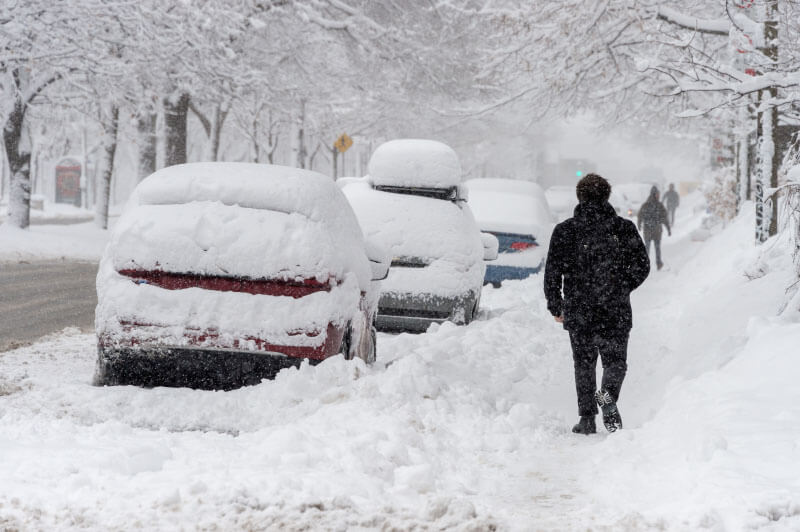The minute winter weather hits in the first big snow of the season, everyone’s commute becomes just a bit more complicated. Whether you walk, drive, or ride the bus, the winter commute takes more planning and preparation. With a few hints and tips, getting to work can be a whole lot more manageable for both employers and employees.
Commuting Tips for Employees
Regardless of what winter weather comes your way, a few strategies can help you arrive on time safely, whether you drive, walk, or ride the bus.
Driving
According to the 2018 census, the average driving commute to work is 27 minutes. Studies also show that more auto accidents occur in winter when driving conditions can be dicey, especially between 8:00 a.m. and 8:29 a.m. What can you do to preserve your car and your safety when the weather seems hazardous?
- Leave early. Depending on your commute, even 5 minutes can make a big difference in traffic. If you’re able to leave early, you’ll be less stressed about being late and the roads will be less busy.
- Allow extra time to shovel and scrape. You never know when you’ll be plowed in, or how long it might take to make sure your car is cleared and defrosted for a safe drive.
- Share the commute. You or your co-worker may be the better winter driver or may have a car that’s better equipped for the weather.
- Slow down. Reaction times are different in cold and snowy conditions, so it can take up to 10 times longer to stop during a storm. Pay attention to the road ahead and start braking well in advance of an intersection.
- Check online road reports immediately before leaving. This way you can avoid any major traffic backups. You can tune in to your favorite local TV or radio station, news website, or your state’s driving conditions map. Particularly in snowy states, websites, this type of information is essential. See the Michigan Department of Transportation’s driving conditions map for an example.
- Be ready for an alternate route. Once you head out, you can use a GPS that has real-time traffic conditions from users in case of traffic jams. Even though you know how to get to work, plug in your work address to ask for directions anyway. It might guide you to a different route to avoid an accident.
Walking

If you’re close enough that you can walk to work, you’ll probably leave a little earlier to brave the snowy sidewalks. What else can you do to make the route more manageable in winter weather?
- Dress warm. Throw on an extra layer, plus a hat and warm gloves, to keep the chill from setting in.
- Use boots with cleats for safety in icy conditions. Once you know how well the paths in your area are generally maintained, you can choose boots with Vibram soles or add slip-on traction devices like YakTrax any time conditions get slick. Some cleats are designed for ice or snow, and you can add them to your regular boots for safety when the weather goes south.
Riding the bus

Bus commuters have to be prepared for walking, standing around outdoors waiting for the bus, and dealing with changes to the bus schedule.
- Be ready to walk. All the walking tips mentioned above would apply.
- Be ready to stand. In case the bus is late, slip a hand warmer into your pocket that can be activated if you have to stand and wait in the cold winter weather.
- Have a backup plan in case the bus is late. Before you even head to the bus stop, you can check the bus system’s application for messages about delays, and you can search for a nearby stop where the bus might get you to your destination sooner. Moovit is one useful app that can give you up-to-date information about the fastest route to your destination.
Other winter issues
Of course, snow and ice can affect more than just your commute, so it pays to be prepared for winter in other ways too. If you have a family, there’s a good chance you might have to be responsible for their needs as well.
Daycare can be an issue when schools are closed at the last minute, so try to line up alternatives ahead of time. Perhaps a high school student in your neighborhood could watch the kids on a day when school is called off.
Also, if the kids’ bus is not on time, or if they are unable to walk through the snow, transporting them to school can affect your morning routine. Try to have a plan for who you can call to help give kids a ride if needed so everyone can get where they need to be.
Employer Actions to Help Their Workers
Employers can also prepare for those days when the storm blows in and employees face challenges. Some solutions that can help both employers and employees navigate particularly bad weather include:
- Allow employees to work from home on extremely bad weather days, if at all possible.
- Be flexible about start times, or send employees home early, so workers can commute during safer time periods.
- After employees arrive at work, offer a paid 10-minute pause break with free hot beverages and suggestions on how to de-stress. You might find yourself using this service too once you get there! How does this help?
- Workers are not as productive upon arrival to work after a white-knuckle drive.
- They also may make more mistakes or even cause an injury when severely stressed.
- Workers may be stressed thinking about their loved ones commuting and whether they made it OK.
- Line up a list of emergency daycare options for employee use. Depending on the importance of the employee being there, offer to reimburse them for all or part of the emergency daycare service.
- On exceptionally poor-weather days, arrange to have critical employees picked up by someone with a more weather-reliable vehicle. That’s exactly what happened during a snowstorm that dropped almost 2 feet of snow on West Michigan. Harrison Electric’s key employees were needed to repair switchgear that had failed and resulted in thousands of area customers without power. The company owner took his 4-wheel drive vehicle and drove to key employees’ homes to pick them up. Now that’s resourceful!
Whether you are commuting or dealing with a whole team of commuters, winter can be a lot more bearable if you have a plan in place for how to manage the snow and ice to reach your destination.


